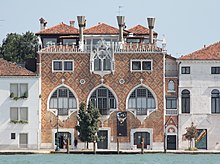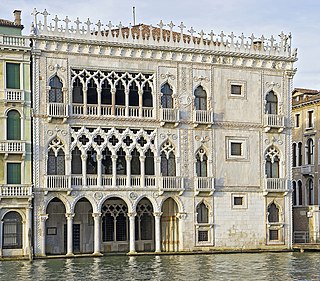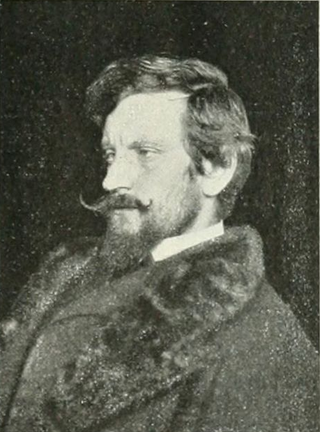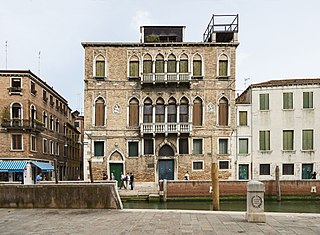
The Casa dei Tre Oci or Casa di Maria is a modern, neo-Gothic palace located on the island of Giudecca of the sestiere of Dorsoduro in Venice. The facade is visible across the Giudecca Canal from the Church of the Zitelle.

The Casa dei Tre Oci or Casa di Maria is a modern, neo-Gothic palace located on the island of Giudecca of the sestiere of Dorsoduro in Venice. The facade is visible across the Giudecca Canal from the Church of the Zitelle.
La Casa dei Tre Oci was designed in 1912-1913 by the Bolognese painter Mario de Maria as his own house. It is stated that the symbolism of the facade is that the three large windows represent Maria's immediate family: his son, wife, and himself, while the smaller upper window represents his then-daughter Silvia, who had recently died in her youth. The Italian term for the eye (occhi) in the Venetian language is òci, hence the house's name.
After the Maria family, the palace was occupied for a spell by the architect Renzo Piano. In 2016, the house was owned by Polymnia Venezia Srl, a cultural institution promoting twentieth-century art. In the 1960s, Fulbright scholars Wolf Kahn, William T. Bradshaw, Richard Miller, and William Eddelman lived and worked in the building. During those years, it was known as the Casa de Maria. Many noted painters lived and worked there, including Friedensreich Hundertwasser and his wife, as well as Pegeen Vail Guggenheim. Miss Berheimer, who was an assistant to Max Reinhardt, also resided there. American painter Edward Melcarth was also listed as a brief resident in the early 1950s and was regarded with suspicion by the FBI, along with other U.S. citizens residing at the address, because they "dedicated themselves to the paintings that exemplify social and political themes." [1] There were several separate apartments and art studios. At one time, the top floor was used by the American Consulate. The historic gondola, once in the lobby, is now in the Venice Arsenale Museum.
The Fondazione di Venezia acquired the building in 2000 and reopened it in 2012 post-refurbishment [2] as a gallery for photography exhibitions. [3] In 2021, Nicolas Berggruen signed a preliminary agreement to purchase the building, with plans to use the space to host symposia, workshops, and exhibitions in partnership with major museums. [4]
The Casa dei Tre Oci is open Everyday from 10am - 7pm (closed on Tuesdays)
It is located on the island of Giudecca and is mostly easily reached by the Zitelle vaporetto stop.
TIckets cost €12 in person or €9 with the MyPass Venezia App.
The current on display is the Letizia Battaglia Exhibition until August 18, 2019. [5]

The Venice Biennale is an international cultural exhibition hosted annually in Venice, Italy, by the Biennale Foundation. It focuses on contemporary art, and includes events for art, contemporary dance, architecture, cinema, and theatre. Two main components of the festival are known as the Art Biennale and the Architecture Biennale, which are held in alternating years. The others – Biennale Musica, Biennale Teatro, Venice Film Festival, and Venice Dance Biennale – are held annually. The main exhibition held in Castello alternates between art and architecture, and there are around 30 permanent pavilions built by different countries.

The Grand Canal is the largest channel in Venice, Italy, forming one of the major water-traffic corridors in the city.

The Ca' d'Oro, or Palazzo Santa Sofia, is a palace on the Grand Canal in Venice, northern Italy. One of the older palaces in the city, its name means "golden house" due to the gilt and polychrome external decorations that once adorned its walls. Since 1927, it has been used as a museum, as the Galleria Giorgio Franchetti.

Ca' Rezzonico is a palazzo and art museum on the Grand Canal in the Dorsoduro sestiere of Venice, Italy. It is a particularly notable example of the 18th century Venetian baroque and rococo architecture and interior decoration, and displays paintings by the leading Venetian painters of the period, including Francesco Guardi and Giambattista Tiepolo. It is a public museum dedicated to 18th-century Venice and one of the 11 venues managed by the Fondazione Musei Civici di Venezia.

Giambattista Pittoni or Giovanni Battista Pittoni was a Venetian painter of the late Baroque or Rococo period. He was among the founders of the Academy of Fine Arts of Venice, of which in 1758 he became the second president, succeeding Tiepolo.

Villa Pisani at Stra refers to the monumental, late-Baroque rural palace located along the Brenta Canal at Via Doge Pisani 7 near the town of Stra, on the mainland of the Veneto, northern Italy. This villa is one of the largest examples of Villa Veneta located in the Riviera del Brenta, the canal linking Venice to Padua. The patrician Pisani family of Venice commissioned a number of villas, also known as Villa Pisani across the Venetian mainland. The villa and gardens now operate as a national museum, and the site sponsors art exhibitions.

Venetian Gothic is the particular form of Italian Gothic architecture typical of Venice, originating in local building requirements, with some influence from Byzantine architecture, and some from Islamic architecture, reflecting Venice's trading network. Very unusually for medieval architecture, the style is at its most characteristic in secular buildings, with the great majority of surviving examples of the style being secular.

Santa Maria del Rosario, commonly known as I Gesuati, is an 18th-century Dominican church in the Sestiere of Dorsoduro, on the Giudecca canal in Venice, northern Italy. The classical style building has a well-lit interior and is exceptional in preserving its original layout and Rococo decoration intact. The church and almost all its sculpture and paintings were created within a thirty-year period: construction began in 1725, the church was consecrated in 1743, and the last sculptural decoration was in place by 1755.

Italian Gothic architecture (also called temperate Gothic architecture, has characteristics that distinguish it considerably from those of the place of origin of Gothic architecture, France, and from other European countries in which this language has spread.

Le Zitelle, or “The Spinsters” is a church in Venice, Italy. It is part of a former complex which gave shelter to young maidens who had no dowry, and is on the eastern part of the Giudecca island. To the east of Le Zitelle, lies Il Redentore, which was constructed around the same time.

The Palazzo Dario is a palace located between the Palazzo Barbaro Wolkoff and the narrow Rio delle Torreselle on the Grand Canal in the sestiere of Dorsoduro, of the city of Venice, Italy. The palace was built in the Venetian Gothic style and was renovated in Renaissance style.

Nicolas Berggruen is a US-based billionaire investor and philanthropist. Born in Paris, France, he is a dual German and American citizen. He is the founder and president of Berggruen Holdings, a private investment company and the co-founder and chairman of the Berggruen Institute, a non-profit, non-partisan think tank that works to address global governance issues. In 2014, through the Institute, Berggruen launched Noema Magazine, formerly the WorldPost, a digital and print publication dedicated to exploring global issues.

The Palazzo Grimani of Santa Maria Formosa is a State museum, located in Venice in the Castello district, near Campo Santa Maria Formosa.

Palazzo Foscari is a Gothic style palace in Venice, built in the 14th century; it is located at the civic number 795 in the island of Giudecca, near the Molino Stucky.
Isola di San Clemente is a small island in the Venetian Lagoon in Italy. For centuries it housed a monastic settlement, and more recently an asylum. It is now the site of a luxury hotel.

Mario or Marius de Maria was an Italian painter, known for depicting nocturnal landscapes, and gaining the label by the contemporary poet Gabriele D’Annunzio, as the painter of moons.
Save Venice Inc. is a U.S. non-profit organization dedicated to the conservation of art and architecture and the preservation of cultural heritage sites in Venice, Italy. Headquartered in New York City, it has an office in Venice, a chapter in Boston, and supporters across the United States and Europe.

Palazzo Giovanelli is a palace in Venice, located in the Santa Croce district, overlooking the right side of the Grand Canal and the Rio di San Giovanni Decollato, before the Fondaco dei Turchi.

Palazzo D'Anna Viaro Martinengo Volpi di Misurata, also known as Palazzo Talenti D'Anna Volpi, is a Renaissance palace in Venice, Italy, located in the San Marco district, overlooking the left side of the Grand Canal, between Palazzo Tron and Casa Marinoni and opposite of Palazzo Donà a Sant'Aponal.

Palazzo Barbarigo Nani Mocenigo is a Gothic palace in Venice, Italy located in the Dorsoduro district, along the Nani embankment on the San Trovaso canal, near the Campo San Trovaso.